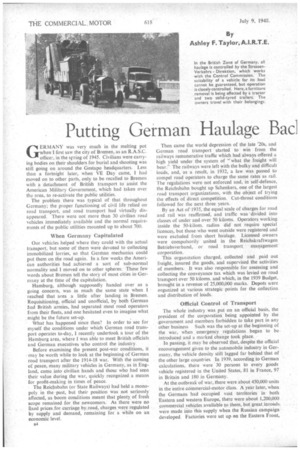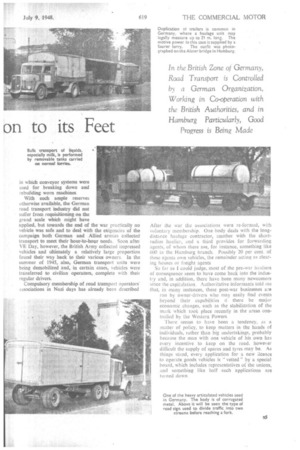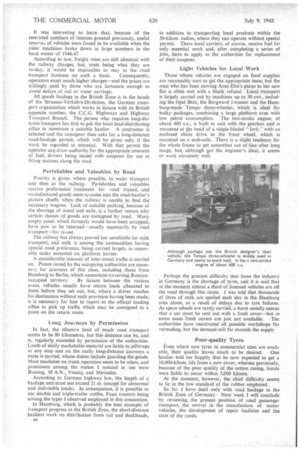Putting Getman Haulage Bacl
Page 38

Page 39

Page 40

If you've noticed an error in this article please click here to report it so we can fix it.
on to its Feet
GERMANY was very much in the melting pot when I first saw the city of Bremen, as an R.A.S.C. officer, in the spring of 1945. Civilians were carrying bodies on their shoulders for burial and shooting was still going on around the Gestapo headquarters. Less than a fortnight later, when VE Day came, I had moved on to other parts, only to be recalled to Bremen with a 'detachment of British transport to assist the American Military Government, which had taken over the area, to re-activate the public utilities.
The problem there was typical of that throughout Germany; the proper functioning of civil life relied on road transport, and road transport had virtually disappeared. There were not more than 30 civilian road vehicles immediately available and the normal requirements of the public utilities mounted up to about 700.
When Germany Capitulated Our vehicles helped where they could with the actual transport, but some of them were devoted to collecting immobilized lorries, so that German mechanics could put them on the road again. In a few weeks the American authorities had achieved a sort of sub-normal normality and I moved on to other spheres.. These few words about Bremen tell the story of most cities in Germany at the time of the capitulation.
Hamburg, although supposedly handed over as a going concern, was in much the same state when I reached that area a little after landing in Bremen. Requisitioning, official and unofficial, by both German And British armies, had separated most road operators from their fleets, and one hesitated even to imagine what
might be the future set-up. .
What has happened since then? In order to see for myself the conditions under which German road transport operates to-day, I recently undertook a tour of the Hamburg area, where I was able to meet British officials and German executives who control the industry.
Before examining the present post-war conditions, it may be worth while to look at the beginning of German road transport after the 1914-18 war. With the coming of peace, many military vehicles in Germany, as in England, came into civilian hands and those who had seen their value during the war, quickly recognized a means for profit-making in times of peace.
The Reichsbahn (or State Railways) had held a monopoly, in the past, but their position was not seriously affected, as boom conditions meant that plenty_ of fresh scope remained for the newcomers. As there were no fixed prices.for carriage by road, charges were regulated by supply and demand, remaining for a While on an economic level.
B4 Then came the world depression of the late '20s, and German road transport started to win from the railways remunerative traffic which had always offered a high yield under the system of "what the freight will bear." The railways were left with the bulky and difficult loads, and, as a result, in 1932, a law was passed to compel road operators to charge the same rates as rail. The regulations were not enforced and, in self-defence, the Reichsbahn bought up Schenkers, one of the largest road transport organizations, with the object of trying the effects of direct competition. Cut-throat conditions followed for the next three years.
By an Act of 1935, the equal scale of charges for road and rail was reaffirmed, and traffic was divided into classes of under and over 50 kiloms. Operators working inside the 50-kilom. radius did not require special licences, but those who went outside were registered and were excluded from short haulage. Licensed owners were compulsorily united in the Reichskraftwagen Betriebsverband, or road transport management corporation.
This organization charged, collected and paid out freight, insured the goods, and supervised the activities of members. It was also responsible for assessing and collecting the conveyance tax which was levied on road 'transport over 50 kiloms. and which, in the 1939 Budget, brought in a revenue of 25,000,000 marks. Depots were organized at various strategic points for the collection and distribution of loads.
Official Control of Transport
The whole industry was put on an official basis, the president of the corporation being appointed by the _government and members forbidden to take part in any other business Such was the set-up at the beginning of the war, when emergency regulations began to be , introduced and a marked change took place.
In passing, it may be observed that, despite the official encouragement given to the automobile industry in Germany, the vehicle density still lagged far behind that of the other large countries. In 1939, according to German calculations, there were 30 persons to every goods vehicle registered in the United States, 81 in France, 97 in Britain and 180 in Germany.
At the outbreak .of war, there were about 450,000 units in the entire commercial-motor class. A year later, when the Germans had occupied vast territories in both Eastern and western Europe, there were about 1,200,000 commercial vehicles available to them, but great inroads were made into this supply when the Russian campaign developed Factories were set up en the Eastern Front,
in which conveyor systems were
used for breaking down and rebuilding worn machines.
With such ample 'reserves otherwise available, the German road transport industry did not suffer from requisitioning on the grand scale which might have applied, but towards the end of the war practically no vehicle was safe and to deal with the exigencies of the campaign both German and Allied armies collected transport to meet their hour-to-hour needs. Soon after VE Day, however, the British Army collected impressed vehicles and ultimately a relatively large proportion found their way back to their various owners. In the summer of 1945, also, German transport units were being demobilized and, in certain cases, vehicles were transferred to civilian operators, ,complete with their regular drivers.
Compulsory membership of road transport operators' associations in Nazi days has already been described After the war the associations were re-formed, with voluntary membership. One body deals with the longdistance haulage contractor, another with the shortradius haulier, and a third provides for forwarding agents, of whom there are, for instance, something like 600 in the Hamburg branch. Possibly 20 per cent. of these agents own vehicles, the remainder acting as clearing houses or freight agents So far as 1 could judge, most of the pre-war hauliers of consequence seem to have come back into the industry and, in addition, there have been many newcomers since the capitulation. Authoritative informants told me that, in many instances, these post-war businesses are run by owner-drivers who may easily find events beyond their capabilities it there be major economic changes, such as the stabilization of the Mark which took place recently in the areas controlled by the Western Powers.
There seems to have been a tendency, as a matter of policy, to keep matters in the hands of individuals, rather than big undertakings, probably because the man with one vehicle of his own has every incentive to keep on the road, however difficult the supply of spares and tyres may be. As things stand, every application for a new licence to operate goods vehicles is " vetted " by a special board, which includes representatives of the unions, and something like half such applications are
fumed down.
It was interesting to learn that, because of the restricted numbers of licences granted previously, useful reserve of vehicles were found to be available when the older machines broke down in large numbers in the hard winter of 1946-47 According to law, freight rates are still identical with the railway charges, but, costs being what they arc to-day, it. would be impossible to stay in the road transport business on such a basis. Consequently, operators exact much higher charges—and the prices are willingly paid by those who are fortunate enough to avoid delays of rail or water carriage.
All goods haulage in the British Zone is in the hands of the Strassen-Verkehrs-Direktion, the German transport organization which works in liaison with its British opposite number, the C.C.G. Highways and Highway Transport Branch. The person who requires long-distance transport has first to ipsk the local load-distributing office .to nominate a Suitable haulier. A contractor is selected and the consignor then asks for a long-distance road-haulage permit, which will be given only if the work be regarded as essential. With that permit the operator can draw authority for the appropriate amounts of fuel, drivers being issued with coupons for use at filling stations along the road.
Perishables and Valuables by Road Priority is given, where possible, to water transport and then to the railway. Perishables and valuables receive preferential treatment for road transit; and manufactured goods seem to come into the road-haulier's picture chiefly when the railway is unable to find the necessary wagons. Lack of suitable packing; because of the shortage of wood and nails, is a further reason why certain classes of goods are consigned by road. Many empty cases, which formerly would have been scrapped, have now to be returned—usually necessarily by road transport—for re-use.
The railway has always proved too unreliable for milk transport, and milk is among the commodities having special road preference, being carried largely in removable tanks mounted on platform lorries.
A considerable amount of inter-zonal traffic is carried on. Passes issued by the occupying authorities are necessary for journeys of this class, including those from Hamburg to Berlin, which necessitate traversing Russianoccupied territory By liaison between the various areas, vehicles usually have return loads allocated to them before they set out, but, where a driver reaches his destination without such provision having been made, it is necessary for him to report to the official loading office to pick up traffic which may be consigned to a point on the return route:
Long Journeys by Permission
In fact, the effective limit of much road transport seems to be 80 kilometres, but this distance can be, and is, regularly exceeded by permission of the authorities. Loads of easily marketable material are liable to pilferage at any stop and on the really long-distance journeys a mate is carried, whose duties include guarding the goods. Most machines on trunk operation seem to be oilers, and prominent among the makes 1 noticed in use were Bussing, M A.N., Vomag and Mercedes.
According to German highway law, the length of a haulage unit must not exceed 21 m. (except for abnormal and indivisible loads). In consequence, it is possible to use double and triple-trailer outfits, Faun tractors being among the types I observed employed in this connection.
In Hamburg, which is probably the best example of transport progress in the British Zone, the short-distance hauliers work on distribution from rail and dockheads, u6 in addition to transporting local products within the 50-kilom. radius, where they can operate without special permit. There local carriers, of course, receive fuel for only essential work and, after completing a series of jobs, have to apply to the authorities for replacement of their coupons.
Light Vehicles for Local Work Those whose vehicles are engaged on food supplies are reasonably sure to get the appropriate issue, but the man who has been moving Aunt Elsa's piano to her new flat is often met with a blank refusal. Local transport is largely carried out by machines up to 30 cwt., including the Opel Blitz, the Borgward 1-tonner and the Hamburg-made Tempo three-wheeler, which is ideal for bulky packages, combining a large platform area with low petrol consumption. The two-stroke engine, of about 400 c.c., is built in unit with the gearbox and is mounted at the head of a single-bladed "fork," with an enclosed chain drive to the front wheel, which is mounted on a stub-axle. There is a slight tendency for the whole frame to get somewhat out of line after long usage, but, although got the engineer's ideal, it seems to work extremely well.
Perhaps the greatest difficulty that faces the industry in.Gerrnany is the shortage of tyres, and it is said that at the moment alrhost a third of licensed vehicles are off the road through this cause. I was told that thousands of litres of milk are spoiled each day in the Hamburg area alone, as a result of delays due to tyre failures. As spare wheels are rarely carried, a burst usually means that a car must be sent 'out with a fresh cover—but in some cases fresh covers are just not available. • The authorities have reactivated all possible workshops for retreading, but the demand still far exceeds the supply.
Poor-quality Tyres
Even where new tyres in commercial sizes are avail able, their quality leaves much to be desired. One haulier told me happily that he now expected to get a 10,000-kilom, life from a new cover, whereas previously, because of the poor quality of the cotton casing, bursts were liable to occur within 5,000 kiloms.
At the moment, however, the chief difficulty seems to lie in the low standard of the rubber employed.
So far I have dealt only with road haulage in the British Zone of Germany. Next week I will conclude by reviewing the present position of road passenger transport, the revival in the manufacture of motor vehicles, the development of repair facilities and the state of the roads.




















































































